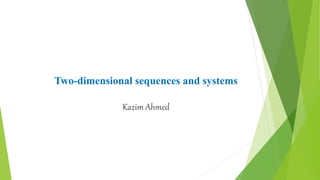Kazim .pptx
•Download as PPTX, PDF•
0 likes•9 views
Two-dimensional sequences and systems
Report
Share
Report
Share

Recommended
More Related Content
Similar to Kazim .pptx
Similar to Kazim .pptx (20)
Welcome to International Journal of Engineering Research and Development (IJERD)

Welcome to International Journal of Engineering Research and Development (IJERD)
3 intensity transformations and spatial filtering slides

3 intensity transformations and spatial filtering slides
LTI System, Basic Types of Digital signals, Basic Operations, Causality, Stab...

LTI System, Basic Types of Digital signals, Basic Operations, Causality, Stab...
A novel approach for high speed convolution of finite

A novel approach for high speed convolution of finite
NEW METHOD OF SIGNAL DENOISING BY THE PAIRED TRANSFORM

NEW METHOD OF SIGNAL DENOISING BY THE PAIRED TRANSFORM
NEW METHOD OF SIGNAL DENOISING BY THE PAIRED TRANSFORM

NEW METHOD OF SIGNAL DENOISING BY THE PAIRED TRANSFORM
NEW METHOD OF SIGNAL DENOISING BY THE PAIRED TRANSFORM

NEW METHOD OF SIGNAL DENOISING BY THE PAIRED TRANSFORM
Recently uploaded
Differences between analog and digital communicationanalog-vs-digital-communication (concept of analog and digital).pptx

analog-vs-digital-communication (concept of analog and digital).pptxKarpagam Institute of Teechnology
Recently uploaded (20)
Involute of a circle,Square, pentagon,HexagonInvolute_Engineering Drawing.pdf

Involute of a circle,Square, pentagon,HexagonInvolute_Engineering Drawing.pdf
21scheme vtu syllabus of visveraya technological university

21scheme vtu syllabus of visveraya technological university
Seizure stage detection of epileptic seizure using convolutional neural networks

Seizure stage detection of epileptic seizure using convolutional neural networks
analog-vs-digital-communication (concept of analog and digital).pptx

analog-vs-digital-communication (concept of analog and digital).pptx
NEWLETTER FRANCE HELICES/ SDS SURFACE DRIVES - MAY 2024

NEWLETTER FRANCE HELICES/ SDS SURFACE DRIVES - MAY 2024
Filters for Electromagnetic Compatibility Applications

Filters for Electromagnetic Compatibility Applications
Research Methodolgy & Intellectual Property Rights Series 2

Research Methodolgy & Intellectual Property Rights Series 2
Passive Air Cooling System and Solar Water Heater.ppt

Passive Air Cooling System and Solar Water Heater.ppt
What is Coordinate Measuring Machine? CMM Types, Features, Functions

What is Coordinate Measuring Machine? CMM Types, Features, Functions
Software Engineering Practical File Front Pages.pdf

Software Engineering Practical File Front Pages.pdf
Kazim .pptx
- 1. Two-dimensional sequences and systems Kazim Ahmed
- 2. Two-dimensional sequences and systems Two-dimensional sequences and systems are mathematical models used to represent and analyze signals or data that vary in two dimensions, such as images, video, and distributed measurements.
- 3. Two-dimensional sequences A two-dimensional sequence is a function of two discrete variables, usually denoted as x(n1, n2), where n1 and n2 are integers. Each point (n1, n2) in the two-dimensional plane is associated with a value x(n1, n2). For example, a grayscale image can be represented as a two- dimensional sequence, where each pixel location corresponds to a value in the sequence. Figure: Grayscale image.
- 4. Two-dimensional systems A two-dimensional system is an operator that maps an input sequence x(n1, n2) to an output sequence y(n1, n2). A two-dimensional system can be represented by a two-dimensional impulse response function h(n1, n2), which describes the output of the system when the input is a unit impulse at position (n1, n2).
- 5. Two-dimensional sequences and systems can be analyzed using various mathematical tools such as linear algebra, differential equations, and probability theory. They can be convolved using a two-dimensional convolution operation, transformed using two-dimensional Fourier transforms, and processed using various signal processing techniques such as filtering, edge detection, and feature extraction.
- 6. Properties of Two-dimensional sequences and systems Two-dimensional sequences can be viewed as a collection of one-dimensional sequences, where each row or column of the two-dimensional sequence is a one-dimensional sequence. Two-dimensional systems are operators that map an input sequence x(n1,n2) to an output sequence y(n1,n2). They can be linear or nonlinear, time-invariant or time-varying.
- 7. Properties of Two-dimensional sequences and systems Two-dimensional systems can be represented by a two-dimensional impulse response function h(n1,n2), which describes the output of the system when the input is a unit impulse at position (n1,n2). Two-dimensional sequences and systems can be convolved using a two-dimensional convolution operation. The output sequence is given by the sum of the products of the input sequence and the flipped and shifted impulse response function.
- 8. Properties of Two-dimensional sequences and systems It can be transformed using two-dimensional Fourier transforms, which decompose the signal into its frequency components. The two-dimensional Fourier transform of a sequence x(n1,n2) is given by X(k1,k2), where k1 and k2 are the frequency variables. Two-dimensional sequences and systems can be analyzed using various mathematical tools such as linear algebra, differential equations, and probability theory.